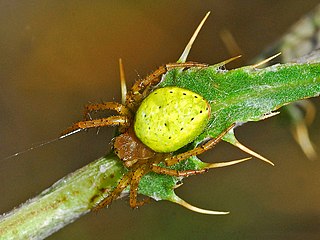
Scaffold web spiders (Nesticidae) is a family of araneomorph spiders closely allied with tangle web spiders. Like the "Theridiidae", these spiders have a comb of serrated bristles on the hind tarsi that are used to pull silk bands from the spinnerets. It contains 16 genera and about 300 species, many of which are associated with caves or overhangs. The genus Nesticus is the type for the family and is found throughout the world. The related Eidmannella has speciated considerably in Texas caves and includes some extremely localized species that are considered threatened. One species, Eidmannella pallida, is found in caves and under overhangs, but also in agricultural fields and other habitats away from such restricted areas. The genus Carpathonesticus is found in central Eurasia.

Tegenaria is a genus of fast-running funnel weavers that occupy much of the Northern Hemisphere except for Japan and Indonesia. It was first described by Pierre André Latreille in 1804, though many of its species have been moved elsewhere. The majority of these were moved to Eratigena, including the giant house spider and the hobo spider.

The parti-coloured bat or rearmouse is a species of vesper bat that lives in temperate Eurasia, from Western and Southern Europe, eastwards over the Caucasus and Iran into Mongolia, north-east China, Korea, Afghanistan and northern Pakistan.

Zoropsis spinimana is a spider species belonging to the family Zoropsidae.

Tarantulas comprise a group of large and often hairy spiders of the family Theraphosidae. Currently, 1,010 species have been identified. The term "tarantula" is usually used to describe members of the family Theraphosidae, although many other members of the same infraorder (Mygalomorphae) are commonly referred to as "tarantulas" or "false tarantulas". Some of the more common species have become popular in the exotic pet trade. Many New World species kept as pets have setae known as urticating hairs that can cause irritation to the skin, and in extreme cases, cause damage to the eyes.

Zygoballus sexpunctatus is a species of jumping spider which occurs in the southeastern United States where it can be found in a variety of grassy habitats. Adult spiders measure between 3 and 4.5 mm in length. The cephalothorax and abdomen are bronze to black in color, with reddish brown or yellowish legs. The male has distinctive enlarged chelicerae and front femora. Like many jumping spiders, Z. sexpunctatus males exhibit ritualized courtship and agonistic behavior.

Clubiona corticalis, the bark sac spider, is a species of spider belonging to the family Clubionidae.

The Scottish wildcat is a European wildcat population in Scotland. Estimates of the numbers vary between 1,000 and 4,000 individuals, many of which are hybridised with domestic cats, and of which it is thought that fewer than 400 cats meet the morphological and genetic criteria of a wildcat. The Scottish wildcat was once widely distributed across Great Britain, but the population has declined drastically since the turn of the 20th century due to habitat loss and persecution. It is now limited to northern and eastern Scotland. It is listed as Critically Endangered in the United Kingdom, threatened by both hybridization with domestic cats as well as more immediate, large-scale threats to their remaining habitat due to increased human demand for natural resources. Camera-trapping surveys carried out in the Scottish Highlands between 2010 and 2013 revealed that wildcats live foremost in mixed woodland, whereas feral and domestic cats were photographed mostly in grasslands.

Cheiracanthium erraticum, the two-clawed hunting spider, is a species of Palearctic spider of the family Cheiracanthiidae.

Phylloneta impressa is a species of comb-footed spider from the genus Phylloneta with a Holarctic distribution.

Heliophanus cupreus, the copper sun jumper, is a species of jumping spider belonging to the family Salticidae.

Zora is a genus of spiders in the family Miturgidae, consisting of small to medium entelegyne, ecribellate spiders. They can be identified as they have two claws with claw tufts, distinct longitudinal bands on the cephalothorax, 4-2-2 arrangement of the eight eyes and long overlapping spines on the first two tibiae and metatarsi. Their abdomens show distinct colour patterns which may be useful in identification to species. There are 17 species in the genus which have a Holarctic distribution, mostly in Europe and the Middle East but with two species in North America. The type species is Zora spinimana.

Zora spinimana is a prowling spider of the family Miturgidae with a Palearctic distribution. It is the type species of the genus Zora.

Philodromus aureolus, the wandering crab spider, is a mainly European running crab spider of the family Philodromidae. The taxonomy of the species group named after Philodromus aureolus is in a state of flux and a number of new species have recently been recognised.

Iberina montana, the common combtailed spider, which was formerly better known as Hahnia montana, is a species of dwarf sheet spider, family Hahniidae, which is found mainly in Europe.

Tetragnatha montana, commonly known as the silver stretch spider, is a species of long-jawed orb weaver from the family Tetragnathidae that has a Palearctic distribution. It preys mostly on flies and mosquitoes. The name silver stretch spider refers to its shiny metallic colour and its habit of extending its legs into a stick like shape.

Araniella opisthographa is a species of orb weaver in the spider family Araneidae.

Nesticus cellulanus, also known as the cavity spider or comb-footed cellar spider, is a species of scaffold web spider. It is found throughout Europe and Turkey, and has been introduced to North America.


















